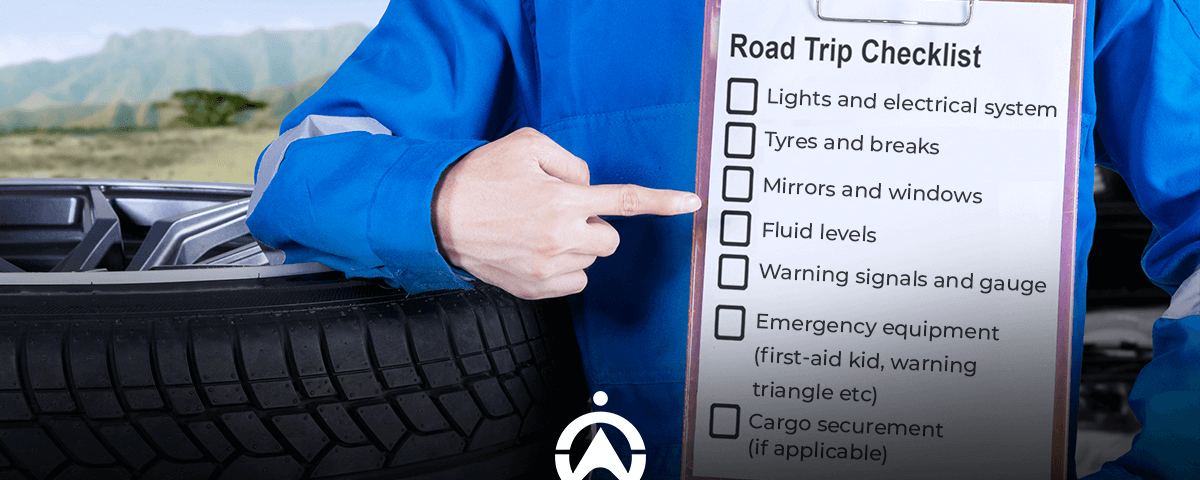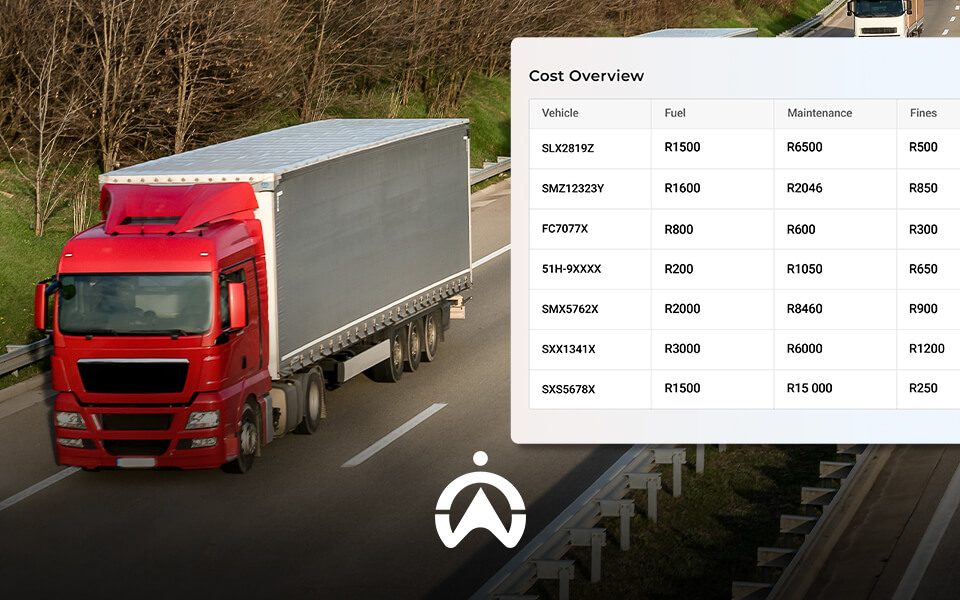Pre-Trip Inspections: Why It Is Still a Powerful Safety Step to Your Fleet Management
Picture yourself rushing down a busy highway, and then, suddenly, your engine sputters and dies. You’re stranded on the roadside, realising that a simple maintenance check could have prevented this costly delay.
Now, imagine this on a larger scale; in a fleet of vehicles, for example. Failing to encourage your drivers to do pre-trip inspections could result in vehicle issues, downtime, and costly damage control.
Let’s dive into some quick and easy safety pre-inspection steps that can save lives and cut costs.
Preventative safety measures in fleet management with a pre-trip inspection list
Engine sputters are just one example of the potential consequences of skipping a pre-trip inspection. In a worst-case scenario, a malfunctioning brake system or a faulty light on a dark road can lead to a devastating accident that puts your driver and other motorists at risk.
A pre-trip inspection checklist can help reduce safety woes. It involves a series of vehicle checks that drivers undertake before driving off. These checks target essential elements like your lights, tyres, and brakes to ensure that the vehicle is functioning correctly and that it’s safe for driving.
It serves several key purposes:
- Early detection of issues: A thorough pre-trip inspection helps catch minor problems like a flickering headlight or low tyre pressure before it becomes a costly issue. Addressing these issues promptly prevents them from developing into major breakdowns that could leave you or your drivers stranded on the road.
- Improved safety: By ensuring all vehicle systems are functioning properly (brakes, lights, mirrors), pre-trip inspections significantly reduce the risk of accidents. This not only protects drivers and other road users but also minimises potential legal liabilities for your business.
- Compliance with regulations: In South Africa, the National Road Traffic Act and South African government outlines specific roadworthiness requirements for commercial vehicles. Pre-trip inspections ensure your vehicles comply with these regulations, avoiding hefty fines and potential vehicle impoundment.

What should be on your pre-trip inspection checklist?
The specific items on your pre-trip inspection checklist will vary depending on the type of vehicles in your fleet (trucks, buses, and vans) and the industry you’re in. However, some general categories should be included in every checklist:
✓ Lights and electrical system:
Check the headlights, taillights, brake lights, turn signals, hazard lights, and clearance lights for proper operation and ensure lenses are clean and undamaged.
✓ Tyres and brakes:
Inspect all tyres for proper inflation (refer to the manufacturer’s recommendations) and visible damage (cuts, bulges, and excessive wear). Ensure all lug nuts are secure. Perform a gentle brake check to ensure proper operation (no pulling or pulsating).
✓ Mirrors and windows:
Adjust all mirrors (rearview and side mirrors) for optimal visibility and ensure they are clean and free of obstructions. Inspect the windscreen for cracks, chips, and obstructions in the driver’s view.
✓ Fluid levels:
Check engine oil, coolant, windscreen washer fluid, and power steering fluid levels, topping them up if necessary.
✓ Warning signals and gauges:
Scan all warning lights and gauges on the dashboard for proper operation. Note any unusual readings (oil pressure, temperature, battery).
✓ Emergency equipment:
Check that the vehicle has a proper functioning fire extinguisher, first-aid kit, and warning triangles (reflectors).
Cargo securement (if applicable):
✓ Cargo area:
Ensure the cargo area is clean and free of any previous cargo remains. Verify proper cargo door operation and security.
✓ Cargo securing measures:
For vehicles transporting goods, check that all cargo is properly secured using appropriate restraints (tie-downs, straps, etc.) following South African National Road Traffic Act regulations. Ensure that the load distribution is balanced to prevent weight shifting during transit.
What is the purpose of a pre-inspection checklist?
While the appeal of hitting the road and getting the job done quickly is understandable, neglecting pre-trip inspections can have significant consequences for your fleet. These inspections are the cornerstone of proactive safety measures and a strong maintenance strategy.
Which of the following is the most important reason for doing a pre-trip inspection?
- To ensure your drivers are safe.
- To prevent costly downtime and repairs.
- To maintain vehicle reliability and compliance.
The correct answer is… all the above!
Apart from having a pre-trip inspection checklist, there’s more you can do to make sure every trip runs smoothly. To ensure a safe drive to every destination, the following five proactive measures are essential:
- Regular vehicle maintenance:
Scheduled servicing is the backbone of preventative maintenance practices as it helps catch potential issues early, prevent breakdowns, ensure your fleet vehicles are always roadworthy, and minimises the overall risk of unexpected breakdowns.
- Driver training:
Providing drivers with safety training is crucial. This includes teaching defensive driving techniques, recognising hazards, and responding effectively to emergencies.
- Driver monitoring and feedback:
Installing driver monitoring systems allows fleet managers to keep an eye on driver behaviour, spot risky driving habits, and give personalised feedback and guidance. By tackling unsafe driving habits early on, managers can minimise the risk of accidents and boost overall safety.
- Technology integration: Advancements in fleet management technology have revolutionised safety practices. Telematics systems, onboard cameras, and GPS tracking devices provide real-time insights into vehicle performance, driver behaviour, and road conditions. By leveraging these handy, high-tech tools, fleet managers can identify areas for improvement, proactively address safety risks, and monitor compliance with safety protocols.
Pre-trip inspections vs vehicle servicing
Pre-trip inspections and vehicle servicing are both essential components of fleet management, each serving different purposes in ensuring fleet vehicle safety and reliability.
- Pre-trip inspections
These are quick but thorough health check-ups conducted by drivers to spot any issues with their vehicles before starting a trip.Pre-trip inspections serve as the first step in promoting proactive vehicle safety. They empower drivers to take responsibility for their vehicles’ condition by following a checklist of essential items to ensure everything is in working order for a safe trip.
In essence, preventative safety measures are the cornerstone of effective fleet management. By detecting and addressing issues before using the vehicle, pre-trip inspections help prevent accidents, breakdowns, and costly repairs while en route as well as fleet longevity in the long run by regularly checking on your vehicles’ health.
- Vehicle servicing
This is a more comprehensive and formal process conducted regularly as part of preventative maintenance practices.Servicing involves scheduled appointments with certified mechanics or service centres to perform a range of tasks aimed at ensuring the continued health and performance of the vehicle. Mechanics inspect and fix issues, change fluids, and replace worn-out parts to keep your vehicle running smoothly. It’s a more thorough and formal process done regularly to increase effectiveness and prevent bigger problems down the road.
Unlike pre-trip inspections, which focus on immediate safety concerns, vehicle servicing addresses broader maintenance needs and helps prolong the lifespan of fleet vehicles.
Quick check or deep clean? Here’s what your fleet needs
Here’s a basic breakdown of the differences between pre-trip inspections and vehicle services. So, which one is more important
The answer? Both!
Pre-trip inspections are a vital first step in identifying potential problems that might later escalate into issues requiring professional servicing. While both pre-trip inspections and vehicle servicing play crucial roles in fleet maintenance, they serve different needs and complement each other in ensuring fleet vehicles’ overall safety and reliability.
How does fleet management software help with vehicle inspections?
Gone are the days of paper checklists and manual record-keeping. Fleet management software offers a digital solution to streamline pre-trip inspections and enhance overall vehicle safety.
Here’s how software can assist:
- Automated reminders: Drivers receive automatic reminders on their mobile devices to perform pre-trip inspections before each shift, promoting consistency and reducing the risk of skipped inspections.
- Accurate reporting: Inspection findings can be recorded electronically, allowing for accurate data collection and analysis. This data can be used to identify recurring issues and improve maintenance practices.
- Telematics integration: Advanced software can integrate with telematics systems to monitor vehicle health in real time. This provides additional insights into potential problems that might not be readily apparent during a pre-trip inspection.
Fleet management software like Cartrack’s enhances the efficiency of pre-trip inspections by providing accurate data and real-time monitoring of vehicle health and performance.

Improve your pre-trip inspections with Cartrack Namibia solutions
Cartrack’s solutions go above and beyond standard software offerings and present a holistic, user-friendly approach to tracking and managing drivers, cargo, and vehicle health.
Here’s how Cartrack Namibia features can elevate your pre-trip inspection program:
Real-time vehicle health monitoring: Cartrack’s advanced telematics system delivers instant insights into the well-being of your vehicles. This advanced feature helps identify potential issues that may not be apparent during routine pre-trip inspections. This aids in preventing breakdowns, reduces fleet repair costs and enhances overall safety.
Preventative maintenance scheduling: With real-time and historical data, Cartrack suggests optimal service intervals that help prevent breakdowns and ensure vehicles are always in top condition.
Reminders and notifications: Cartrack uses this proactive feature to send timely reminders to both drivers and fleet managers for upcoming maintenance needs and scheduled pre-trip inspections.
Detailed reports: Generate comprehensive reports that inform fleet managers of their vehicles’ health, pre-trip inspection data, and vehicle-related issues like low oil levels. These reports offer valuable insights for enhancing overall fleet safety and efficiency.
CANBus integration: For newer vehicles equipped with a Controller Area Network (CANBus) system, Cartrack seamlessly integrates with the vehicle’s onboard diagnostics (OBD). This integration provides a broader range of real-time data points, offering in-depth insights into vehicle health.
How Cartrack features benefit businesses with their inspection efforts:
- Reduced downtime: Proactive identification and resolving potential issues minimises the risk of breakdowns and keeps your fleet on the road.
- Reduced repair costs: Addressing minor problems early on prevents them from developing into major repairs that are more expensive to fix.
- Compliance with regulations: Regular inspections and preventative maintenance with our features help ensure your fleet meets safety regulations and roadworthiness standards.
- Enhanced vehicle reliability: Remember, a well-maintained fleet experiences fewer breakdowns and operates more efficiently. This leads to increased productivity and profitability.
Cartrack’s fleet management goes beyond managing deliveries and routes. It places safety as a top priority, safeguarding drivers, vehicles, cargo, and everyone on the road.
Take charge of your fleet’s safety
Don’t let a skipped inspection put your drivers, vehicles, and cargo at risk. Invest in proactive safety measures with Cartrack Namibia and ensure your fleet operates smoothly and efficiently.
Contact Cartrack Namibia today to learn more about our comprehensive fleet management solutions and how we can help you implement a robust pre-trip inspection program.



